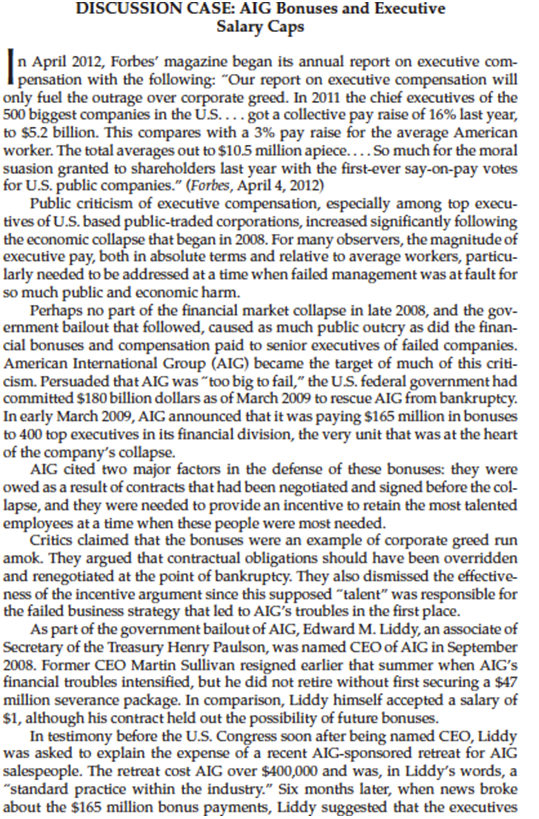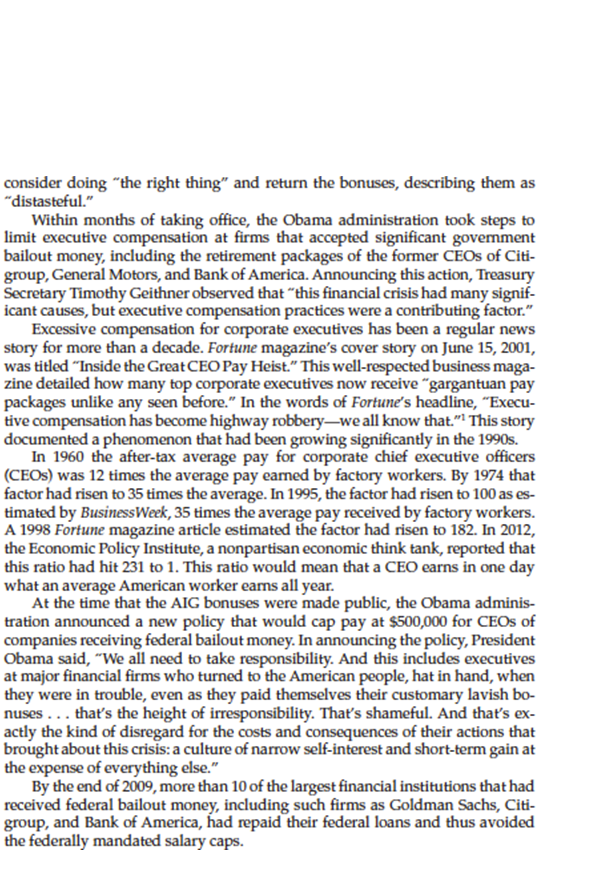Prepare the summary of the case and identify what ethical issues are involved in this case?
Prepare the summary of the case and identify what ethical issues are involved in this case?
Management, Loose-Leaf Version
13th Edition
ISBN:9781305969308
Author:Richard L. Daft
Publisher:Richard L. Daft
Chapter19: Managing Quality And Performance
Section: Chapter Questions
Problem 2OTJVC
Related questions
Question
Prepare the summary of the case and identify what ethical issues are involved in this case?

Transcribed Image Text:DISCUSSION CASE: AIG Bonuses and Executive
Salary Caps
n April 2012, Forbes' magazine began its annual report on executive com-
pensation with the following: "Our report on executive compensation will
only fuel the outrage over corporate greed. In 2011 the chief executives of the
500 biggest companies in the U....got a collective pay raise of 16% last year,
to $5.2 billion. This compares with a 3% pay raise for the average American
worker. The total averages out to $10.5 million apiece....So much for the moral
suasion granted to shareholders last year with the first-ever say-on-pay votes
for U.S. public companies." (Forbes, April 4, 2012)
Public criticism of executive compensation, especially among top execu-
tives of U.S. based public-traded corporations, increased significantly following
the economic collapse that began in 2008. For many observers, the magnitude of
executive pay, both in absolute terms and relative to average workers, particu-
larly needed to be addressed at a time when failed management was at fault for
so much public and economic harm.
Perhaps no part of the financial market collapse in late 2008, and the gov-
ernment bailout that followed, caused as much public outcry as did the finan-
cial bonuses and compensation paid to senior executives of failed companies.
American International Group (AIG) became the target of much of this criti-
cism. Persuaded that AIG was "too big to fail," the U.S. federal government had
committed $180 billion dollars as of March 2009 to rescue AIG from bankruptcy.
In early March 2009, AIG announced that it was paying $165 million in bonuses
to 400 top executives in its financial division, the very unit that was at the heart
of the company's collapse.
AIG cited two major factors in the defense of these bonuses: they were
owed as a result of contracts that had been negotiated and signed before the col-
lapse, and they were needed to provide an incentive to retain the most talented
employees at a time when these people were most needed.
Critics claimed that the bonuses were an example of corporate greed run
amok. They argued that contractual obligations should have been overridden
and renegotiated at the point of bankruptcy. They also dismissed the effective-
ness of the incentive argument since this supposed "talent" was responsible for
the failed business strategy that led to AIG's troubles in the first place.
As part of the government bailout of AIG, Edward M. Liddy, an associate of
Secretary of the Treasury Henry Paulson, was named CEO of AIG in September
2008. Former CEO Martin Sullivan resigned earlier that summer when AIG's
financial troubles intensified, but he did not retire without first securing a $47
million severance package. In comparison, Liddy himself accepted a salary of
$1, although his contract held out the possibility of future bonuses.
In testimony before the U.S. Congress soon after being named CEO, Liddy
was asked to explain the expense of a recent AIG-sponsored retreat for AIG
salespeople. The retreat cost AIG over $400,000 and was, in Liddy's words, a
"standard practice within the industry." Six months later, when news broke
about the $165 million bonus payments, Liddy suggested that the executives

Transcribed Image Text:consider doing "the right thing" and return the bonuses, describing them as
"distasteful."
Within months of taking office, the Obama administration took steps to
limit executive compensation at firms that accepted significant govemment
bailout money, including the retirement packages of the former CEOS of Citi-
group, General Motors, and Bank of America. Announcing this action, Treasury
Secretary Timothy Geithner observed that "this financial crisis had many signif-
icant causes, but executive compensation practices were a contributing factor."
Excessive compensation for corporate executives has been a regular news
story for more than a decade. Fortune magazine's cover story on June 15, 2001,
was titled "Inside the Great CEO Pay Heist." This well-respected business maga-
zine detailed how many top corporate executives now receive "gargantuan pay
packages unlike any seen before." In the words of Fortune's headline, "Execu-
tive compensation has become highway robbery-we all know that."" This story
documented a phenomenon that had been growing significantly in the 1990s.
In 1960 the after-tax average pay for corporate chief executive officers
(CEOS) was 12 times the average pay eamed by factory workers. By 1974 that
factor had risen to 35 times the average. In 1995, the factor had risen to 100 as es-
timated by BusinessWeek, 35 times the average pay received by factory workers.
A 1998 Fortune magazine article estimated the factor had risen to 182. In 2012,
the Economic Policy Institute, a nonpartisan economic think tank, reported that
this ratio had hit 231 to 1. This ratio would mean that a CEO earns in one day
what an average American worker earns all year.
At the time that the AIG bonuses were made public, the Obama adminis-
tration announced a new policy that would cap pay at $500,000 for CEOS of
companies receiving federal bailout money. In announcing the policy, President
Obama said, "We all need to take responsibility. And this includes executives
at major financial firms who turned to the American people, hat in hand, when
they were in trouble, even as they paid themselves their customary lavish bo-
nuses ... that's the height of irresponsibility. That's shameful. And that's ex-
actly the kind of disregard for the costs and consequences of their actions that
brought about this crisis: a culture of narrow self-interest and short-term gain at
the expense of everything else."
By the end of 2009, more than 10 of the largest financial institutions that had
received federal bailout money, including such firms as Goldman Sachs, Citi-
group, and Bank of America, had repaid their federal loans and thus avoided
the federally mandated salary caps.
Expert Solution
This question has been solved!
Explore an expertly crafted, step-by-step solution for a thorough understanding of key concepts.
This is a popular solution!
Trending now
This is a popular solution!
Step by step
Solved in 3 steps

Recommended textbooks for you

Management, Loose-Leaf Version
Management
ISBN:
9781305969308
Author:
Richard L. Daft
Publisher:
South-Western College Pub

Management, Loose-Leaf Version
Management
ISBN:
9781305969308
Author:
Richard L. Daft
Publisher:
South-Western College Pub